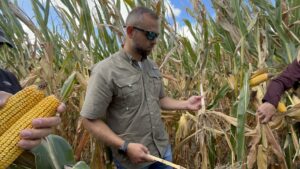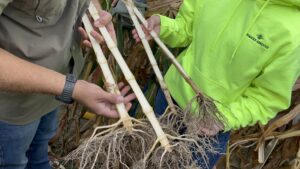By this point in the harvest season, you know how well your corn crop fared in terms of grain, overall yield and quality. While this year’s crop is set, it can still offer you valuable insight for fine tuning your management program for next year. It really comes down to close observation of a mature crop in the field and at the individual plant level to evaluate over the entire growing season.
Like most living organisms, it’s all about energy resources. Your corn is no different. It needs a good steady supply of energy all season long in the form of stored carbohydrates. How well your crop did in this task is easily known by August and September by the plant’s ability to stay green. The more stay-green that is visible at this time of year indicates the overall energy reserves for the plant to use, most importantly for complete grainfill.
When scouting, we can look down a row and tell when a field transitions from one environment to another by the stay-green amount visible. It’s during this time of year that we can look at that lower stalk and really tell the story of what kind of carbohydrate allocation the plant has. But the question remains, is it enough stored carbohydrate to finish out for optimum grain fill?

To get more answers, we like to go a step further in the field and pull off some leaves in a few different environments. Doing that typically reveals what level of stress there is in that particular spot versus another part of the same field. Lower stalk quality usually translates into a poorer grain fill. However, in good plants, where we don’t see infection in the plant’s internodes with disease such as anthracnose or Gibberella stalk rot, we’ll typically see good fill and uniformity from stalk to stalk.
If you dissect a stalk by splitting it down the center, we can really begin to see what the remaining carbohydrate reserves truly are. You can get a real sense of the differences between stressed and unstressed acres by a plant’s carbohydrate retention at this time of year. It’s better to see reserves that remain higher up the stalk (higher internode) as that indicates a higher overall carbohydrate reserve for the plant to use for final grain fill.

By this time of year, we will see many plants with little to no reserve past internode five or six. This reflects the level of seasonal stress the plant has experienced to this point and tells you what energy the plant still has to allocate to grain fill, including kernel size. This is why it’s so important to understand of your field and the recurring stress that you observe in order to maintain the highest level of stay-green . That gives a plant more energy and strength to pack more depth into every kernel — and an overall better yield for you.
We welcome your questions about your 2022 crop yields, carbohydrate allocation or any of the challenges you’ve experienced this growing season. Contact us at info@advancedagrilytics.com or reach out to your local precision agronomist.